The Corsair Force Series GT is an enthusiast-class SSD based on the SandForce SF-2281 processor and SATA 6Gb/s interface. While a little late to the party, the Force Series GT is based on a well-seasoned platform that delivers quoted read speeds of 555MB/s and writes of 525MB/s with 85,000 IOPS. For buyers wanting the latest high-performance SSD coupled with a brand name known for reliable performance, the Force GT is a welcome addition to the SSD landscape.
Corsair now offers a broad line of SSDs based on the SATA 6Gb/s interface. Their first effort came out in April – the Performance 3 uses a Marvell controller and let Corsair get to market with a SATA 6Gb/s SSD quickly. The Force GT and Force 3 of course leverage the SandForce controllers to deliver faster speeds than the Performance 3. Much like the OCZ Vertex 3 and the Agility 3 they face up against, the GT and Force 3 are largely differentiated by NAND. The Force GT gets the faster and more expensive 25nm synchronous NAND, where the mainstream Force 3 uses more cost effective asynchronous NAND.
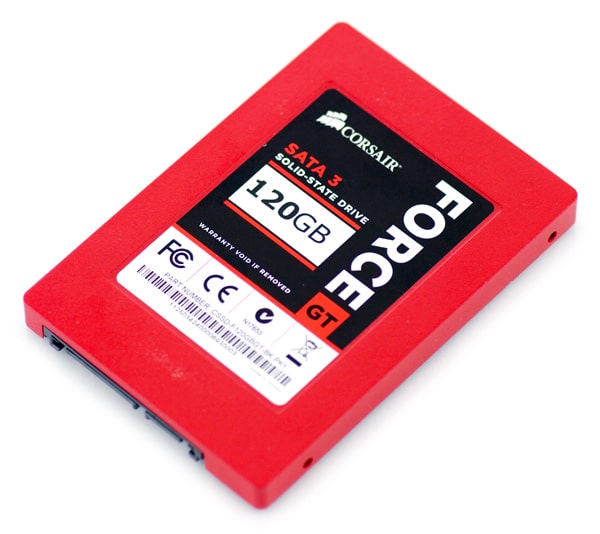
Corsair Force Series GT Specs
- Formatted Capacity – 111.79GB
- SandForce SF-2281 Processor
- 25nm Synchronous IMFT NAND
- 555MB/s Read, 525MB/s write, 85k IOPS (240GB Capacity)
- Power Consumption: 0.6w idle, 2.5w active
- 240GB, 120GB and 60GB Capacities
- MTBF – 2 Million Hours
- 3 Year Warranty
- 2.5″ Form Factor – Includes 3.5″ Bracket
Aesthetics
Corsair really doesn’t hold anything back when it comes to the design of their SSDs. The Force GT offers an all metal case and a very impressive bright red paint scheme. Where other manufacturers have only gone the route of adjusting the color of the sticker, Corsair goes all out. Of course for most this paint won’t matter, but if you have one of the many see-through PC cases, the color is a nice touch.
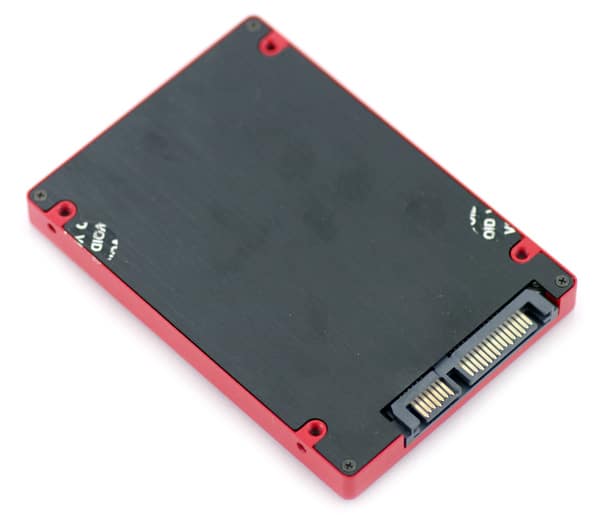
The Force GT uses roughly the same all-metal case design as past models, with the exterior paint color and product sticker being the only significant changes. This design fits the 2.5-inch hard drive spec perfectly, fitting in every notebook drive back and drive sled we have on hand. Corsair also ships a bracket for fitting into 3.5″ drive bays.

The side profile of the drive shows the side mounting holes, which have some minimal paint overspray inside. In some ways this acts as a thread locker, helping to prevent screws from loosening over time, and in the same way causing slightly more effort to turn screws into place.

The front profile includes just the standard SATA power and data connection, with no service pins visible from the exterior.
Disassembly
Taking the Corsair Force GT SSD apart is very simple, although the process of removing the top cover will void the warranty. There is no reason why the end user should ever open the case during normal operation, since even firmware updating can be done through a software interface. The first step in taking apart the Force GT is removing the four fine-tipped Phillips head screws on the back cover. Once these are removed and the warranty stickers are broken, the cover lifts off exposing the circuit board inside.
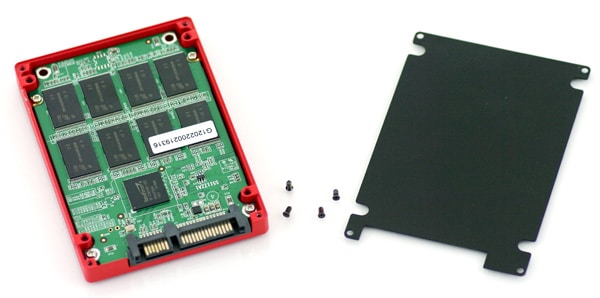
After the cover is removed, there are only four Phillips head screws remaining which hold the PCB to the case. After these are removed the board comes out completely.
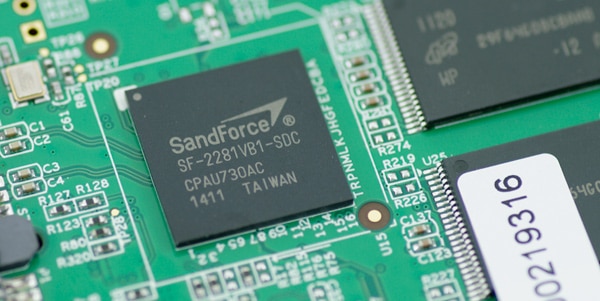
Corsair uses the SandForce SF-2281VB1-SDC processor inside the Force GT SSD. Offering SATA 6Gb/s saturating transfer speeds, this is the de facto controller on the market for any high-performance SSD. Paired up with this controller are sixteen 29F64G08CBAAB 8GB 25nm Micron synchronous NAND pieces, with eight located on each side of the circuit board.
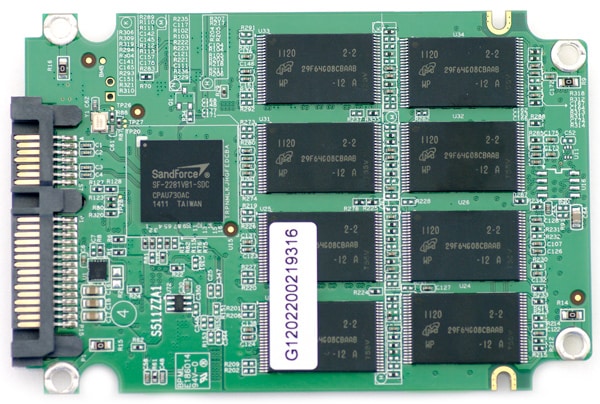
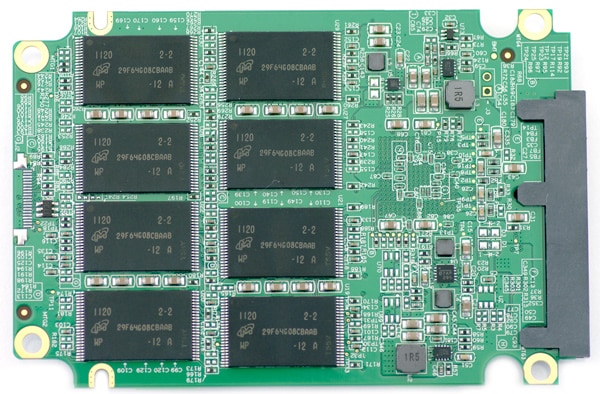
Synthetic Benchmarks
The Force GT SSD is positioned as the top performer in the Corsair line-up, with the Force 3 settling in right below it. Corsair lists the advertised speeds as 555MB/s read and 525MB/s write for the 240GB capacity (555MB/s read 515MB/s write for the 120GB), which is right at the top of the SATA 6Gb/s interface limit. In our first test we directly compare to these results using a 2MB sequential transfer test in IOMeter with both repeating and random data.
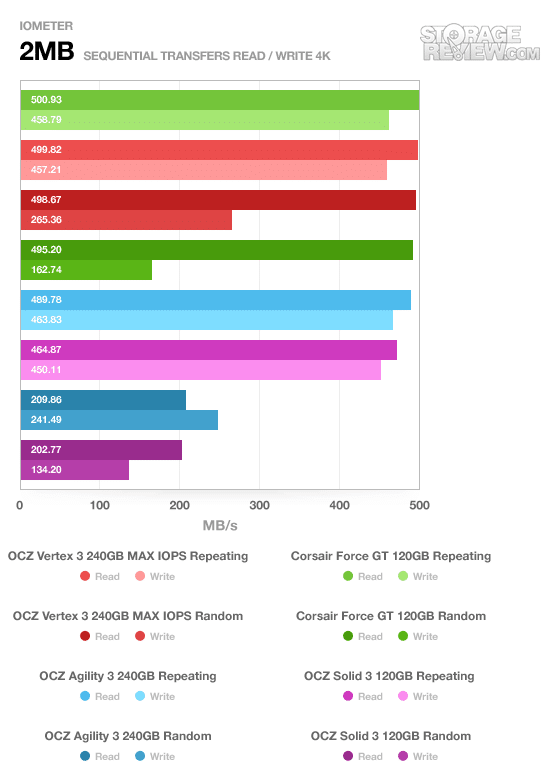
In our test the 120GB Corsair Force GT topped the charts with 500MB/s read and 458MB/s write with repeating data. Using full random data the speeds dropped to 495MB/s read and 162MB/s write.
In the following test we switch from a sequential to random transfer, keeping the same 2MB transfer size.
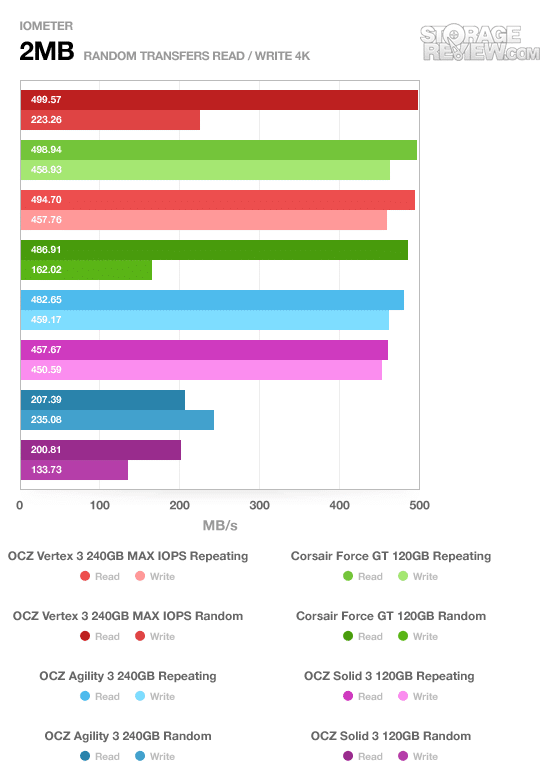
The Force GT slowed to 498MB/s read, but kept the same write speed of 458MB/s with repeating data. With fully random data the speeds slowed to 486MB/s read and 162MB/s write.
Next we look at even smaller transfers in our 4K random test. This area is the bread and butter of any SSD, since flash media has none of the inherent lag of mechanical movement.
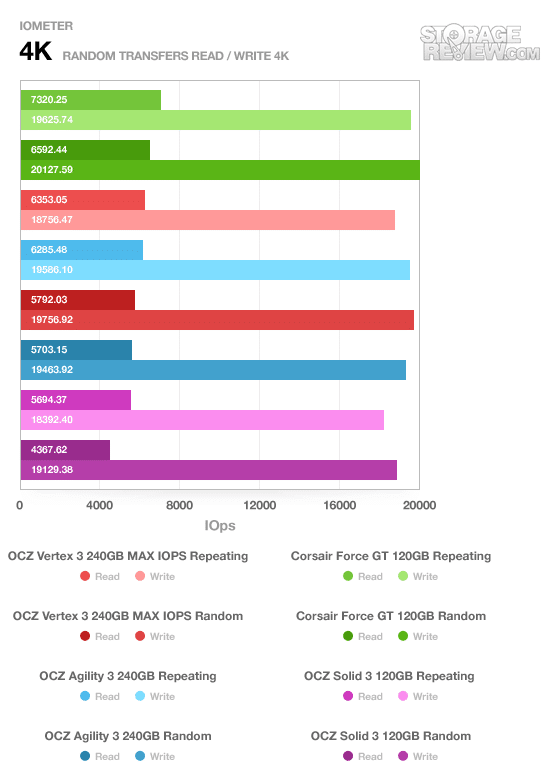
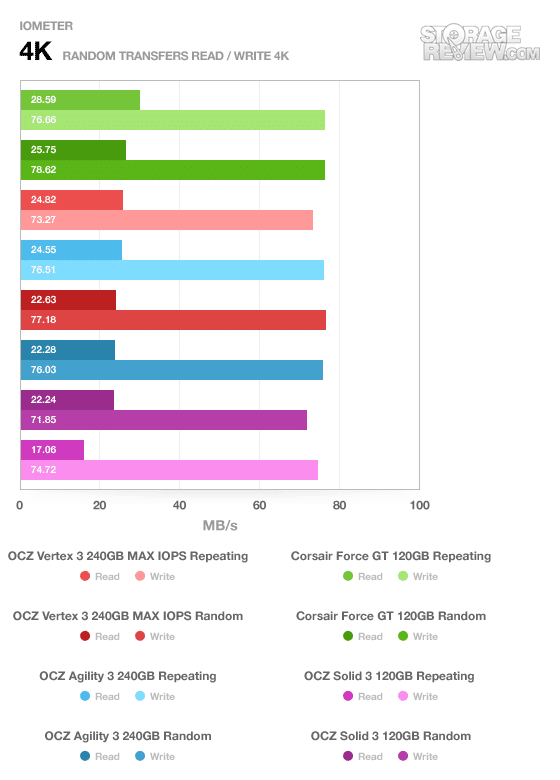
The Corsair Force GT topped the charts with both repeating and fully random data results. Besting the OCZ Vertex 3 MAX IOPS by 1,000 I/O read, it had a wide margin away from any other drive. Write speeds were also significantly faster, with the best score coming in just over 20,000 I/O with fully random data. Just note that this stage of 4K tests are performed at a queue depth of 1, whereas the next group goes up to 64.
Our ramped 4K read and write tests show how drives handle 4K read and write requests in 30 second intervals. Each stages builds upon the last, with no time for recovery in-between.
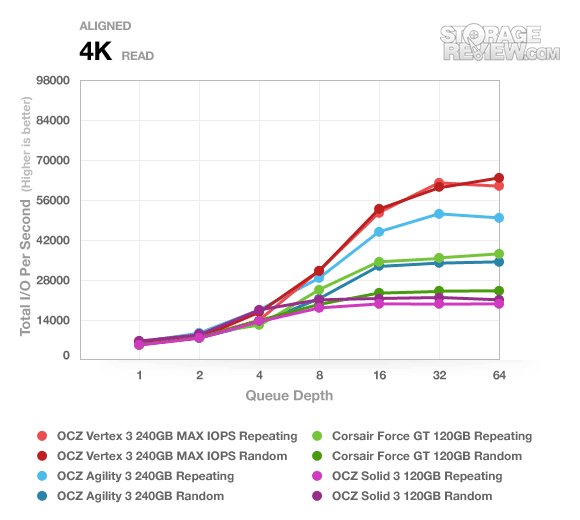
In the 4K read stage of our test the fell behind the 240GB models, with speeds topping out at 37,000 I/O.
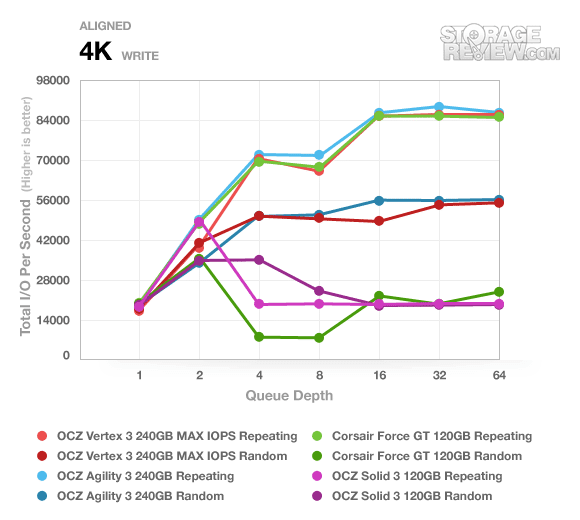
In the write segment of the test, the Force GT had no trouble keeping up with the Vertex 3 MAX IOPS and Agiltiy 3 with repeating data, with a max speed of 85,000 I/O. With fully random data it started off with a strong push to 36,000 I/O before falling down to 9,000 I/O and partially recovering back to just above 20,000 I/O.
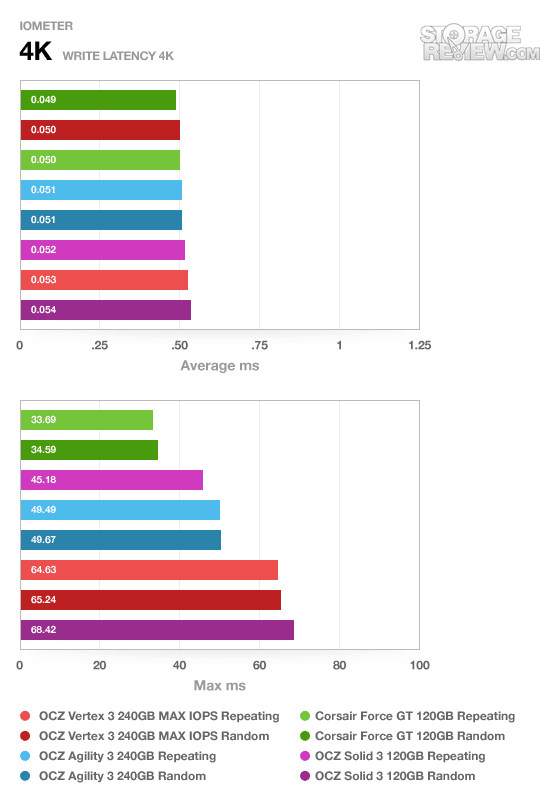
Given the strong initial 4K write performance, the Force GT had no trouble topping the charts in our write latency test. It had both the lowest average time of 0.049ms as well as the lowest maximum access time of 33ms.
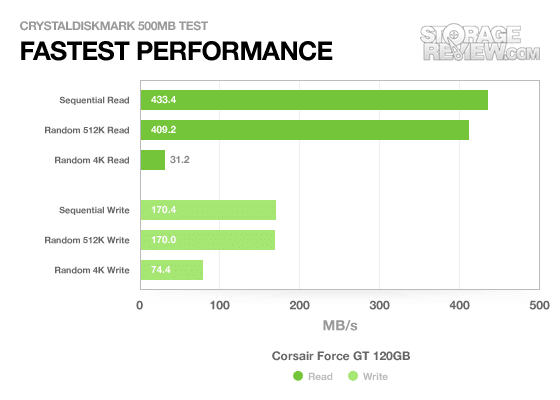
CrystalDiskMark on the random data profile showed very similar results to the IOMeter fully random data tests, although the read speeds were slightly lower and the write speeds were just a tad increased.
The last section of our synthetic benchmarks covers standard IOMeter server profile charts. Similar to the ramped 4K tests, these show how well a drive performs under stress, in a queue depth range varying between 1 to 128. In almost all of the tests the Force GT performed very close to the OCZ Solid 3, although it was hard to get a fair comparison when the size was half the capacity of the other SF-2200 models we reviewed previously.
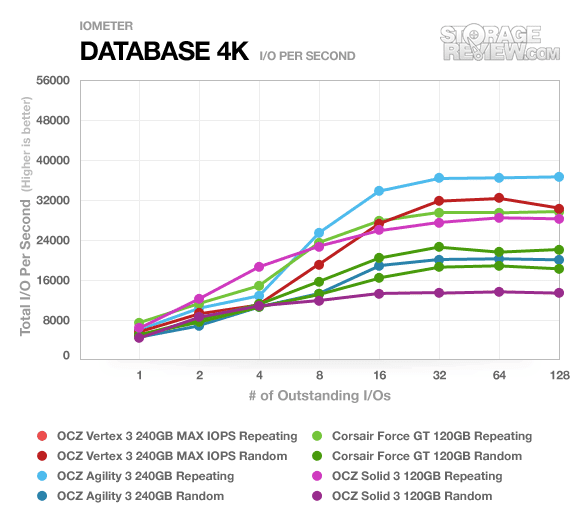
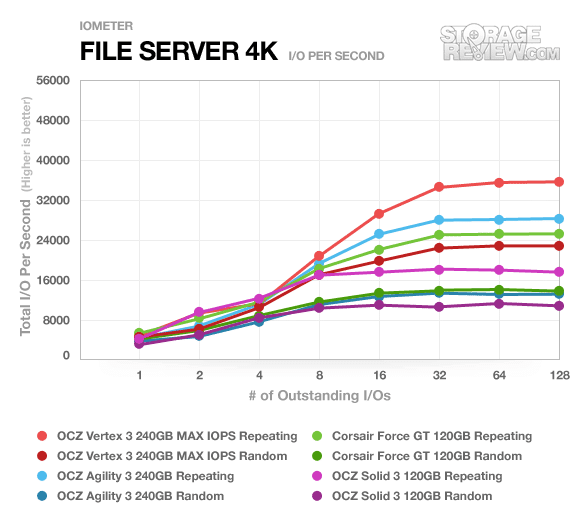
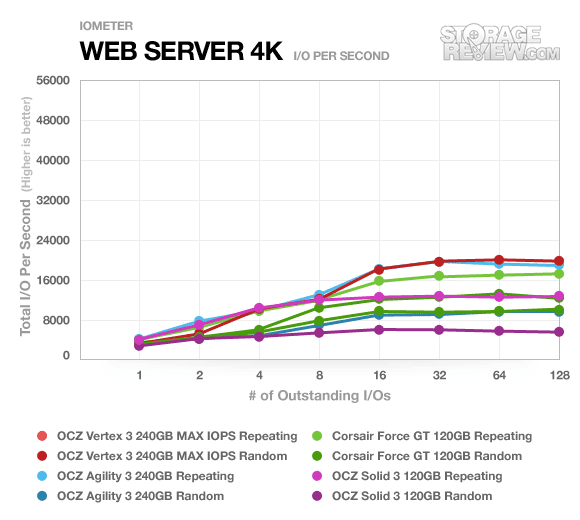
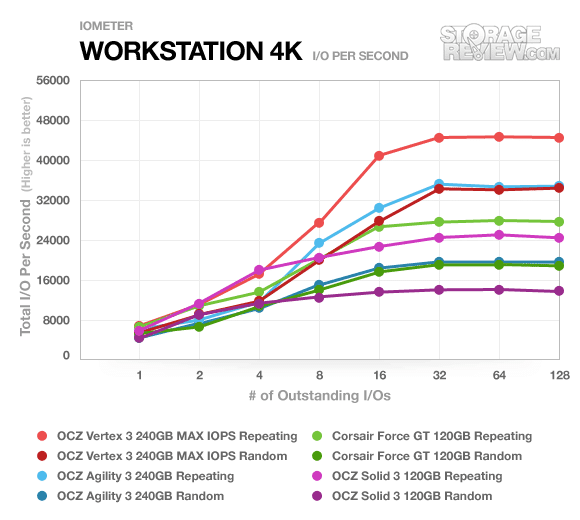
Real-World Benchmarks
If you are new to StorageReview, one thing we try to focus on is how any given drive might perform under real-world conditions. For the average user, trying to translate random 4K write speeds into an everyday situation is pretty difficult. It helps when comparing drives in every setting possible, but it doesn’t exactly work out into faster everyday usage or better game loading times. For this reason we turned to our StorageMark 2010 traces, which include HTPC, Productivity, and Gaming traces to help readers find out how a drive might rank under their conditions.
As we noted above at the end of our server profile tests, the Corsair Force GT is at a slight disadvantage by being a different capacity than the other top-performing SF-2200 models we have reviewed. While all have the same sixteen NAND channels filled, it’s really hard to equally compare drives of different capacities.
The first real-life test is our HTPC scenario. In this test we include: playing one 720P HD movie in Media Player Classic, one 480P SD movie playing in VLC, three movies downloading simultaneously through iTunes, and one 1080i HDTV stream being recorded through Windows Media Center over a 15 minute period. Higher IOps and MB/s rates with lower latency times are preferred. In this trace we recorded 2,986MB being written to the drive and 1,924MB being read.
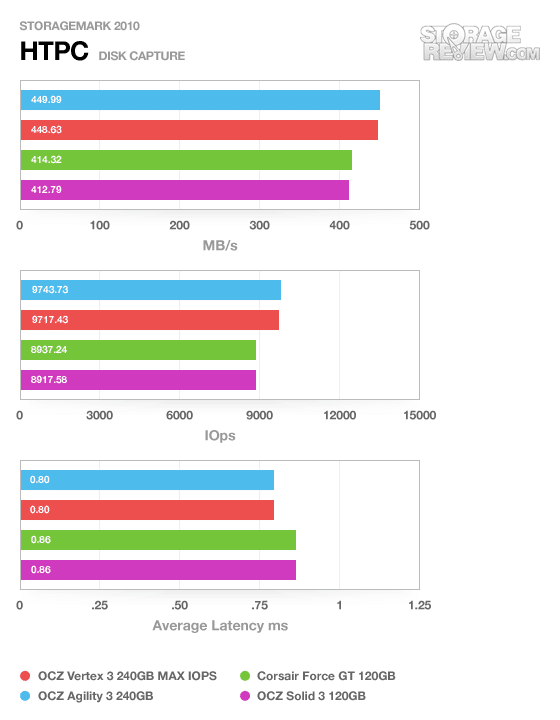
The Corsair Force GT came in 34MB/s behind the 240GB Vertex 3 MAX IOPS and Agility 3 SSDs, but still came out slightly ahead compared to the Solid 3.
Our second real-life test covers disk activity in a productivity scenario. For all intents and purposes this test shows drive performance under normal daily activity for most users. This test includes: a three hour period operating in an office productivity environment with 32-bit Vista running Outlook 2007 connected to an Exchange server, web browsing using Chrome and IE8, editing files within Office 2007, viewing PDFs in Adobe Reader, and an hour of local music playback with two hours of additional online music via Pandora. In this trace we recorded 4,830MB being written to the drive and 2,758MB being read.
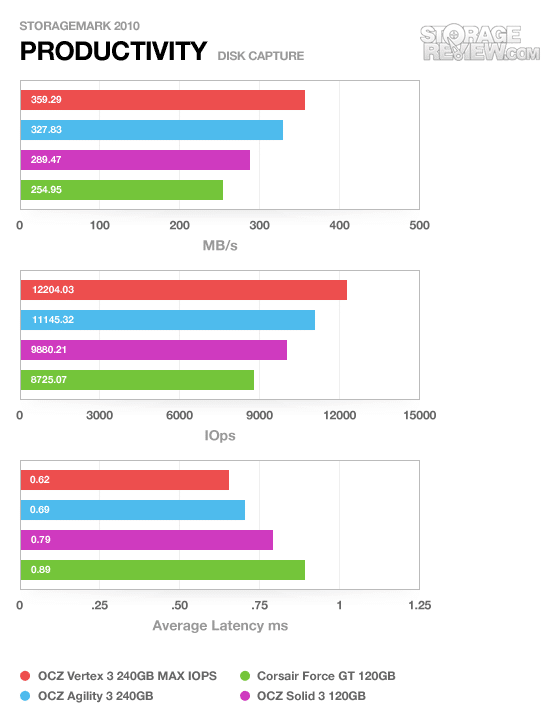
The Force GT really didn’t stay with the pack in our productivity test. Each of the three runs we performed all scored right in the pack and very close the averaged number we published for this test. We are guessing the firmware that allows it to have faster off-the-line performance in some tests has a few downsides in more lengthy benchmarks.
Our third real-life test covers disk activity in a gaming environment. Unlike the HTPC or Productivity trace, this one relies heavily on the read performance of a drive. To give a simple breakdown of read/write percentages, the HTPC test is 64% write, 36% read, the Productivity test is 59% write and 41% read, while the gaming trace is 6% write and 94% read. The test consists of a Windows 7 Ultimate 64-bit system pre-configured with Steam, with Grand Theft Auto 4, Left 4 Dead 2, and Mass Effect 2 already downloaded and installed. The trace captures the heavy read activity of each game loading from the start, as well as textures as the game progresses. In this trace we recorded 426MB being written to the drive and 7,235MB being read.
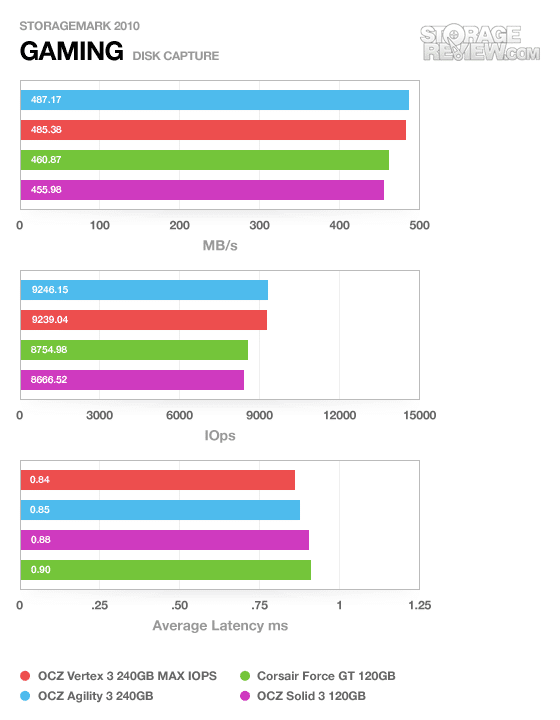
In the final trace the GT picked up speed again, moving back into its 3rd place position ahead of the Solid 3. Coming in 25MB/s slower than the 240GB SSDs, it still performed well, just not at the top.
Power Consumption
Corsair lists the Force GT as having an active power consumption of 2.5 watts and an idle power rate of 0.6 watts. to put these to the test we measured the power consumption during a variety of IOMeter read/write profiles, including a write test with fully random data.
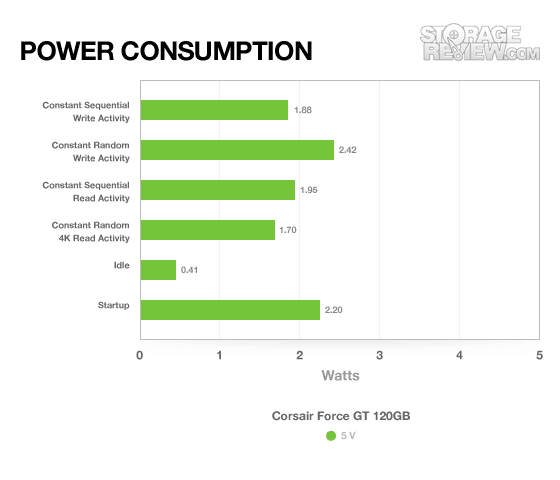
In our standard test which uses repeating data, we measured a write power rate of 1.88 watts and a sequential read rate of 1.95 watts. Those were the two highest values during normal usage besides the 2.20 watts seen during startup. Switching the fully random data for the sequential write test, the power value jumped from 1.88 watts to 2.42 watts. At idle though, where the drive will probably see most of its life in many consumer systems, it only used 0.41 watts.
Warranty
Corsair offers a three-year warranty on the Force GT-series SSDs. This is matched by all many other manufacturers except for Intel and OWC on select 25nm models.
Conclusion
The Corsair Force Series GT is a difficult SSD for us to sum up. The drive excels when it comes to single queue depth transactions, topping the charts, sometimes with wide margins over the main competition from OCZ. The drive looks great too with the red paint and metal body – it simply exudes quality build and materials. Then we get into the higher queue depth operations and real world benchmarks and the drive falls off the charts. So we’re left with a drive that excels at QD=1 but much beyond that it falls behind.
There could be several reasons why this happens and to be fair we are comparing a 120GB Force GT against 240GB drives. Maybe Corsair is using aggressive firmware that’s tweaked for performance in single queue depth scenarios. Thankfully, these issues are likely resolvable with an update if Corsair sees this as a problem.
The other issue we have, which can fluctuate, is price. The Force GT 120GB has a street price of $289 where the Vertex 3 and OWC 6G in the same capacity go for $245 and $279 respectively. Over time the GT will probably drift down toward $250, but today the price isn’t as competitive as it needs to be.
Pros
- Fast off the line performance
- Great looks and build
- Strong 4K write performance
Cons
- Has trouble keeping up in real-world tests
- Struggles with higher queue depth loads
Bottom Line
We really wanted to love the Corsair Force Series GT SSD. At the top of the review it’s easy to get excited, the GT does very well with benchmarks that have a queue depth of one. But much after that and in our real world tests, the drive falls off. We’ll vigilantly watch and hope for a firmware update that brings the GT more in line with other current generation SandForce-based SSDs.
Discuss This Review




 Amazon
Amazon